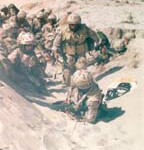
WEDNESDAY, Jan. 27 (HealthDay News) — A technique called mirror therapy can help reduce phantom pain in soldiers who’ve had limbs amputated, a new study shows.
Phantom pain, a common problem after amputation, is pain that’s perceived to be in the missing limb.
“The pain pathways in the spinal cord and brain ‘remember’ the painful injury. Because of this memory, the missing arm or leg continues to ache, sometimes severely so, long after the limb has been amputated,” study author Dr. Steven R. Hanling, of the Naval Medical Center in San Diego, said in a news release.
He and his colleagues found that mirror therapy significantly reduced phantom pain in four soldiers who had suffered severe leg injuries that led to amputation. This made it possible for them to fully participate in their postoperative physical therapy programs.
The study appears in the February issue of the journal Anesthesia & Analgesia.
“In this form of therapy, patients sit with a mirror vertically between the legs and arms so that they are reflected in it. The reflection in the mirror makes it look like the injured arm or leg is healthy and normal,” explained journal editor-in-chief Dr. Steven L. Shafer of Columbia University in New York City.
“Patients then observe and control their injured arm or leg in the mirror — but they are actually observing and controlling the reflected uninjured arm or leg. The brain and spinal cord are visually tricked into believing that all of the arms and legs are intact and without pain,” Shafer said.
More information
The Amputee Coalition of America has more about post-amputation pain.

